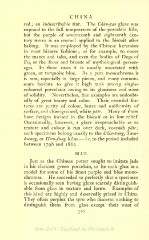Page 384 - Oriental Series Japan and China, Brinkly
P. 384
CHINA
red an indescribable tint. The Chiin-yao glaze was
;
exposed to the full temperature of the porcelain kiln,
but the purple of seventeenth and eighteenth cen-
tury wares is an enamel applied to the biscuit after
baking. It was employed by the Chinese keramists
in most bizarre fashions as for example, to cover
;
the manes and tales, and even the bodies of Dogs of
Fo, or the faces and breasts of mythological person-
ages. In these cases it is usually associated with
green, or turquoise blue. As a pure monochrome it
is rare, especially in large pieces, and many connois-
seurs hesitate to give it high rank among single-
coloured porcelains owing to its glassiness and want
of solidity. Nevertheless, fine examples are undoubt-
edly of great beauty and value. Their essential fea-
tures are purity of colour, lustre and uniformity of
surface, and close-grained, white pate. Many of them
have designs incised in the biscuit or in low relief.
Occasionally, however, a glaze irreproachable as to
texture and colour is run over dark, coarsish pate;
such specimens belong usually to the Chia-tsing, Taou-
kwangy or Hien-fung kilns i.e. to the period included
between 1796 and 1862.
BLUE.
Just as the Chinese potter sought to imitate jade
in his choicest green porcelain, so he took glass as a
model for some of his finest purple and blue mono-
chromes. He succeeded so perfectly that a specimen
is occasionally seen having glaze scarcely distinguish-
able from glass in texture and lustre. Examples of
this kind are highly and deservedly prized in China.
They often perplex the tyro who discerns nothing to
distinguish them from glass except their want of
310

